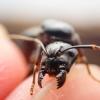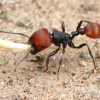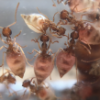1 and a half weeks ago, I caught a prenelopis imparis queen where I live in upstate New York. I have never kept this species before and I haven't had the best of luck with ant queens in general although a lot of it has simply been bad luck. I would post a picture of it but I've heard that they're stressed out pretty easily and I don't want to stress her but I do have a you tube video of her that you can watch.
I will try to post some pictures on here the Friday after this one which is going to be the next time I open up her test tube.


















